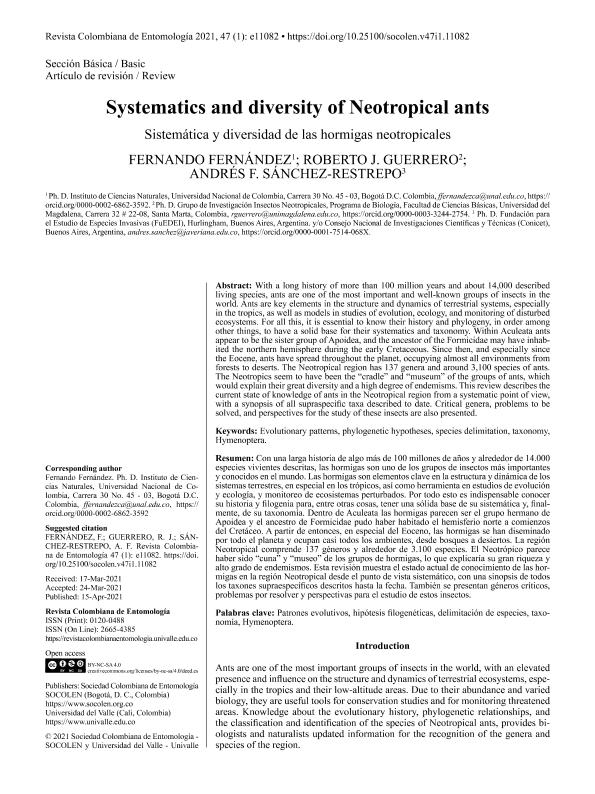Artículo
With a long history of more than 100 million years and about 14,000 described living species, ants are one of the most important and well-known groups of insects in the world. Ants are key elements in the structure and dynamics of terrestrial systems, especially in the tropics, as well as models in studies of evolution, ecology, and monitoring of disturbed ecosystems. For all this, it is essential to know their history and phylogeny, in order among other things, to have a solid base for their systematics and taxonomy. Within Aculeata ants appear to be the sister group of Apoidea, and the ancestor of the Formicidae may have inhabited the northern hemisphere during the early Cretaceous. Since then, and especially since the Eocene, ants have spread throughout the planet, occupying almost all environments from forests to deserts. The Neotropical region has 137 genera and around 3,100 species of ants. The Neotropics seem to have been the “cradle” and “museum” of the groups of ants, which would explain their great diversity and a high degree of endemisms. This review describes the current state of knowledge of ants in the Neotropical region from a systematic point of view, with a synopsis of all supraspecific taxa described to date. Critical genera, problems to be solved, and perspectives for the study of these insects are also presented. With a long history of more than 100 million years and about 14,000 described living species, ants are one of the most important and well-known groups of insects in the world. Ants are key elements in the structure and dynamics of terrestrial systems, especially in the tropics, as well as models in studies of evolution, ecology, and monitoring of disturbed ecosystems. For all this, it is essential to know their history and phylogeny, in order among other things, to have a solid base for their systematics and taxonomy. Within Aculeata ants appear to be the sister group of Apoidea, and the ancestor of the Formicidae may have inhabited the northern hemisphere during the early Cretaceous. Since then, and especially since the Eocene, ants have spread throughout the planet, occupying almost all environments from forests to deserts. The Neotropical region has 137 genera and around 3,100 species of ants. The Neotropics seem to have been the “cradle” and “museum” of the groups of ants, which would explain their great diversity and a high degree of endemisms. This review describes the current state of knowledge of ants in the Neotropical region from a systematic point of view, with a synopsis of all supraspecific taxa described to date. Critical genera, problems to be solved, and perspectives for the study of these insects are also presented.
Systematics and diversity of Neotropical ants
Título:
Sistemática y diversidad de las hormigas neotropicales
Fecha de publicación:
04/2021
Editorial:
Sociedad Colombiana de Entomología; Universidad del Valle
Revista:
Revista Colombiana de Entomología
ISSN:
0120-0488
e-ISSN:
2665-4385
Idioma:
Inglés
Tipo de recurso:
Artículo publicado
Clasificación temática:
Resumen
Archivos asociados
Licencia
Identificadores
Colecciones
Articulos(SEDE CENTRAL)
Articulos de SEDE CENTRAL
Articulos de SEDE CENTRAL
Citación
Fernandez, Fernando; Guerrero, Roberto Ariel; Sánchez Restrepo, Andrés Fernando; Systematics and diversity of Neotropical ants; Sociedad Colombiana de Entomología; Universidad del Valle; Revista Colombiana de Entomología; 47; 1; 4-2021; 1-20
Compartir
Altmétricas




